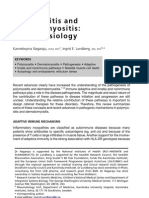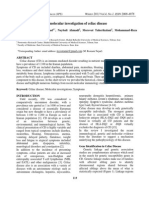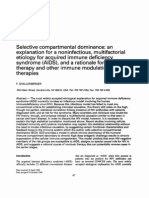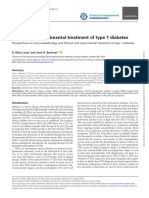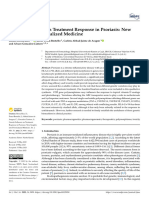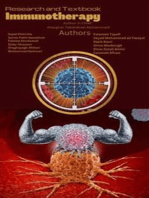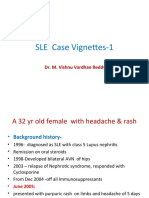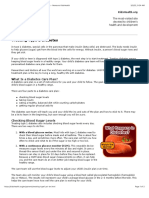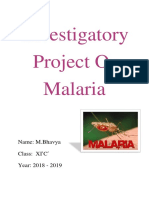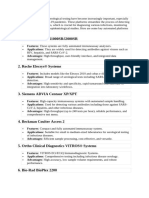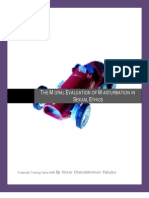Journal of Autoimmune Diseases
Journal of Autoimmune Diseases
Uploaded by
vishnupgiCopyright:
Available Formats
Journal of Autoimmune Diseases
Journal of Autoimmune Diseases
Uploaded by
vishnupgiOriginal Title
Copyright
Available Formats
Share this document
Did you find this document useful?
Is this content inappropriate?
Copyright:
Available Formats
Journal of Autoimmune Diseases
Journal of Autoimmune Diseases
Uploaded by
vishnupgiCopyright:
Available Formats
Journal of Autoimmune Diseases
Hypothesis
BioMed Central
Open Access
Immunogenetic mechanisms for the coexistence of organ-specific and systemic autoimmune diseases
Masha Fridkis-Hareli
Address: Department of Cancer Immunology & AIDS, Dana Farber Cancer Institute, 44 Binney Street, Boston, MA 02115, USA Email: Masha Fridkis-Hareli - masha_fridkis-hareli@dfci.harvard.edu
Published: 15 February 2008 Journal of Autoimmune Diseases 2008, 5:1 doi:10.1186/1740-2557-5-1
Received: 18 December 2007 Accepted: 15 February 2008
This article is available from: http://www.jautoimdis.com/content/5/1/1 2008 Fridkis-Hareli; licensee BioMed Central Ltd. This is an Open Access article distributed under the terms of the Creative Commons Attribution License (http://creativecommons.org/licenses/by/2.0), which permits unrestricted use, distribution, and reproduction in any medium, provided the original work is properly cited.
Abstract
Background: Organ-specific autoimmune diseases affect particular targets in the body, whereas systemic diseases engage multiple organs. Both types of autoimmune diseases may coexist in the same patient, either sequentially or concurrently, sustained by the presence of autoantibodies directed against the corresponding autoantigens. Multiple factors, including those of immunological, genetic, endocrine and environmental origin, contribute to the above condition. Due to association of certain autoimmune disorders with HLA alleles, it has been intriguing to examine the immunogenetic basis for autoantigen presentation leading to the production of two or more autoantibodies, each distinctive of an organ-specific or systemic disease. This communication offers the explanation for shared autoimmunity as illustrated by organ-specific blistering diseases and the connective tissue disorders of systemic nature. Presentation of the hypothesis: Several hypothetical mechanisms implicating HLA determinants, autoantigenic peptides, T cells, and B cells have been proposed to elucidate the process by which two autoimmune diseases are induced in the same individual. One of these scenarios, based on the assumption that the patient carries two disease-susceptible HLA genes, arises when a single T cell epitope of each autoantigen recognizes its HLA protein, leading to the generation of two types of autoreactive B cells, which produce autoantibodies. Another mechanism functioning whilst an epitope derived from either autoantigen binds each of the HLA determinants, resulting in the induction of both diseases by crosspresentation. Finally, two discrete epitopes originating from the same autoantigen may interact with each of the HLA specificities, eliciting the production of both types of autoantibodies. Testing the hypothesis: Despite the lack of immediate or unequivocal experimental evidence supporting the present hypothesis, several approaches may secure a better understanding of shared autoimmunity. Among these are animal models expressing the transgenes of human disease-associated HLA determinants and T or B cell receptors, as well as in vitro binding studies employing purified HLA proteins, synthetic peptides, and cellular assays with antigen-presenting cells and patient's lymphocytes. Indisputably, a bioinformatics-based search for peptide motifs and the modeling of the conformation of bound autoantigenic peptides associated with their respective HLA alleles will reveal some of these important processes. Implications of the hypothesis: The elucidation of HLA-restricted immune recognition mechanisms prompting the production of two or more disease-specific autoantibodies holds significant clinical ramifications and implications for the development of more effective treatment protocols.
Page 1 of 7
(page number not for citation purposes)
Journal of Autoimmune Diseases 2008, 5:1
http://www.jautoimdis.com/content/5/1/1
Background
Autoimmune mucocutaneous blistering diseases (AMBD) such as pemphigus vulgaris (PV), pemphigus foliaceus (PF), bullous pemphigoid (BP), and mucous membrane pemphigoid (MMP), are a group of rare organ-specific diseases that affect skin and multiple mucous membranes [15]. PV is a potentially fatal disease characterized by the loss of intercellular adhesion of keratinocytes, resulting in acantholysis [6-8]. In the serum of PV patients, high titers of circulating autoantibodies targeting the epidermal adhesion molecule desmoglein 3 (Dsg3), one of the keratinocyte transmembrane proteins localized in the desmosome, which is essential for maintaining the integrity of the epidermis, are believed to cause clinical disease by direct binding to and disruption of desmoglein proteins [1,9]. The association of HLA antigens with the susceptibility to PV has been demonstrated in numerous studies [10-14]. It appears that PV is tightly linked to a rare haplotype HLA-DR4 (DRB1*0402) DQwB1*0302 in Ashkenazi Jews. In non-Jewish patients the haplotype is HLA-DRB1*404, DQB1*0503 [15]. Another blistering disease, MMP, which affects mucous membranes of the body, is characterized by the presence of autoantibodies to human 4 integrin [16,17], while BP which predominantly affects the skin, is associated with bullous pemphigoid antigen 1 (BPAg1) and (BPAg2) [18]. Both BP and MMP have been shown to have a strong linkage to HLA-DQB1*0301 [18,19]. It has been demonstrated that the same patient may have antibodies against more than one autoantigen within the skin and mucous membrane resulting in more than one autoimmune mucocutaneous disease. For example, patients with PF may develop BP [20,21]; patients with MMP may have PV [22], and some patients are affected with both PV and ocular cicatricial pemphigoid [23]. In contrast to organ-specific diseases, connective tissue disorders, or systemic diseases, including systemic lupus erythematosus (SLE), rheumatoid arthritis (RA), and systemic sclerosis (SSc), involve multiple tissues and organs [24-26]. Mixed connective tissue disease (MCTD) is a systemic autoimmune syndrome characterized by the pres-
ence of high titers of serum antibodies against small nuclear ribonuclearproteins (U-snRNPs) [27,28], in particular against U1 small nuclear RNP polypeptide (U1 snRNP). It has been suggested that MCTD represents a distinct clinical entity, based on clinical manifestations that separate MCTD from other connective tissue diseases [29]. Various associations of HLA antigens with MCTD have been reported, including HLA-B7 and HLA-Dw1 [30]. In another study, DR4 was found to be significantly increased in MCTD [31], whereas others reported an association between HLA-DQw3 and anti-RNP antibodies in patients with MCTD [32]. Interestingly, MCTD patients with increased IgG autoantibodies against U170 kD polypeptide have an increased prevalence of DR4 antigen compared with controls [33]. Furthermore, molecular biology studies have shown that most MCTD patients carrying DR4 or DR2 alleles share a region of homology consisting of seven amino acids in the DRB1 gene [34]. This "shared epitope" of DR molecules, in different alleles and in different patients with MCTD, may be important for the modulation of the autoimmune response to the U170 kD antigen [35]. HLA associations with organ-specific and systemic autoimmune disorders and their autoantigens are listed in Table 1. It has been well documented that autoimmune diseases may coexist in the same patient, either sequentially or concurrently [21,36-46]. PV, dermatitis herpetiformis, BP, and SLE have all been reported in association with other autoimmune diseases as well as with each other. In particular, observations of dual autoimmunity in some patients who concurrently develop organ-specific and systemic disease have been reported [38,40,41,44,46]. Multiple factors, including those of immunological, genetic, endocrine and environmental origin, contribute to the above condition. The immunogenetic mechanisms of this phenomenon present an intriguing unresolved problem of autoimmune predisposition, calling for development of prospective approaches of prediction and ultimately prevention of the disease. As a matter of fact, the involvement of T cells in immunopathogenesis of MCTD, PV and MMP has been well established. In MCTD, the role of anti-RNPreactive T cells in autoantibody production has been dem-
Table 1: HLA associations with Mixed Connective Tissue Disease and Autoimmune Blistering Diseases
Disease Mixed Connective Tissue Disease Mucous Membrane Pemphigoid Bullous Pemphigoid Pemphigus Vulgaris
HLA allele HLA-B7, HLA-Dw1 HLA-DQw3 HLA-DQB1*0301 HLA-DQB1*0301 HLA-DR4 (DRB1*0402), DQwB1*0302 HLA-DRB1*404, DQB1*0503
Autoantigen U1 sn-RNP polypeptide U1 sn-RNP polypeptide 4 integrin BPAg1 (BP180) BPAg2 (BP230) Dsg3 Dsg3
Reference 30 32 19, 64 18, 64 65 65
Page 2 of 7
(page number not for citation purposes)
Journal of Autoimmune Diseases 2008, 5:1
http://www.jautoimdis.com/content/5/1/1
onstrated [47,48]. In PV, it has been shown that B cells function as antigen-presenting cells stimulating Dsg3-specific CD4+ T helper (Th) cells to secrete cytokines such as interleukin (IL)-4, IL-6 and IL-10 which are required for proliferation of memory B cells and differentiation into antibody-producing plasma cells [49-51]. Thus, the interplay between B and T cells seems to be critical, which is further supported by the finding that depletion of CD4+ T cells prevents antibody production (reviewed in ref. [52]). Moreover, a clinical study showed that the mean frequency of Th2 CD4+ T cells was significantly elevated in PV patients with active disease, while no responses were detected for patients with disease in remission or controls [53]. Characterization of autoreactive T-cells has led to identification of immunodominant T-cell epitopes and the repertoire of Dsg3- or Dsg1-specific T-cells at the clonal level [54,55]. Lastly, the potential role for antigenspecific autoreactive T cells in the pathogenesis of MMP has also been addressed [56,57]. Collectively, these observations suggest that T cell epitopes of the respective autoantigens, i.e. Dsg-3 for PV, 4 integrin for MMP, and U1 snRNP for MCTD, may bind to their HLA molecules and trigger the activation of autoreactive T cells, which in turn would induce production of pathogenic autoantibodies. This mechanism would most probably be applicable to the case of a single disease, however, when two or more autoimmune diseases occur in the same patient, the molecular and cellular events are likely to be more complex. Based on the accumulated evidence of shared autoimmunity, it has been intriguing to investigate the relationship between the genetic and immunological mechanisms for the simultaneous production of two or more autoantibodies. A hypothesis, which in part may explain some of the increased susceptibility to both autoimmune blistering and systemic connective tissue diseases, is presented below.
autoantibodies to Dsg3. In another instance, the DQB allele such as DQB1*0301 could present the BP or MMP antigens and thus induce antibodies to BPAg2 or human 4 integrin subunit. Based on whether the antigen presented is BPAg2 or 4 integrin subunit, the patient may have BP or MMP, respectively. In support to this mechanism, it is noteworthy that the affinity of the binding between the autoantigenic peptide epitope, the susceptible HLA and the TCR plays an important role in T cell activation. Due to certain degree of promiscuity and specificity in peptide recognition by the HLA receptors, not a single binding affinity, but rather a range of affinities would account for the productive interaction between the peptide epitope, HLA and the TCR, leading to T cell-mediated B cell activation and antibody secretion. Of the three autoantigens mentioned in the present study, i.e. snRNP, 4 integrin and Dsg-3, the latter has been characterized most extensively in terms of epitope mapping and HLA binding capacity. Modeling of the bound conformation of PV-associated peptides revealed the role of DRB1*0402 in the selection of specific self-epitopes [58]. Several studies suggest that autoantigenic peptides do not necessarily bind to disease-associated HLA molecules with high affinity, but rather within the intermediate range, thus allowing for the rescue of autoreactive T cells. In contrast, protective HLA proteins are more efficient binders of self-antigens, which results in elimination of autoreactive T cells [58]. The second scenario (Figure 1, central panel, Dual HLA Recognition) applies to the situation when a single epitope of an autoantigen binds to both HLA specificities, leading to the induction of both diseases by cross-presentation and reactivity. Thus, it can not be excluded that there is cross-reactivity in the binding of immunopathogenic epitopes to either of the susceptible genes in the same individual, leading to T cell responses which trigger autoantibody production. For example, if an epitope within Dsg3, 4 integrin, BPAg2, or U1-snRNP is available for antigen presentation, it is possible that such a peptide with the complete homology is present in all four molecules or only in one molecule. However this specific epitope might have the capacity to bind to different HLA determinants. If it binds to DR2 or DR4, it stimulates T cells that induce activation of B cells producing anti-RNP antibodies. If it binds to DRB1*0402 or DQB1*0503, it results in stimulating T cells inducing production of antiDsg3 antibodies. If it binds to DQB1*0301, it stimulates T cells leading to generation of autoantibodies to BPAg2 or 4 integrin. It should be noted that peptide binding to HLA is facilitated by the interactions between the amino acid residues lining the groove of HLA molecules and the side chains of
Presentation of the hypothesis
The schematic representation of the possible immunopathogenic mechanisms leading to breakage of tolerance and induction of the two autoimmune diseases in the same individual is shown in Fig. 1. Theoretically, there can be at least three possible scenarios. The first scenario (left panel, Single HLA Recognition) may apply to the situation when T cell epitopes of the two different autoantigens associate with each of the susceptible HLA molecules, resulting in dual autoimmunity. It will occur when a single epitope of an autoantigen recognizes the disease-linked HLA determinant. For example, in the patient with MCTD and PV, carrying two DR4 alleles, one DR4 allele may bind to the relevant epitope within U1snRNP antigen and produce anti-RNP antibodies. The second DR4 allele, such as DRB1*0402 may bind the relevant epitope of Dsg3 and result in the production of
Page 3 of 7
(page number not for citation purposes)
Journal of Autoimmune Diseases 2008, 5:1
http://www.jautoimdis.com/content/5/1/1
Figure 1 Immunogenetic mechanisms of dual autoimmunity Immunogenetic mechanisms of dual autoimmunity. Coexistence of two autoimmune disorders in the same patient may occur due to multiple mechanisms. Schematic representation of the potential pathways leading to the induction of PV and MCTD is shown on the three panels. Based on the assumption that production of autoantibodies is triggered by T cells interacting with the autoantigenic epitopes bound to the susceptible HLA alleles, the following scenarios are described: 1 (left panel, Single HLA recognition). In this case, each T cell epitope specific for a single disease may associate with its susceptible HLA protein, leading to T cell activation and subsequent stimulation of B cells to produce autoantibodies, which would result in dual autoimmunity. 2 (central panel, Dual HLA Recognition). Here, each of the disease-specific autoantigens may bind to either HLA protein, leading to the induction of both diseases by cross-presentation. 3 (right panel, Dual HLA Recognition). According to this scenario, two distinct epitopes of the same autoantigen may be able to bind two disease-associated HLA molecules. Similar pathways would apply to the situation when MCTD and MMP are presented in the same patient.
the bound peptide. The binding pockets of HLA class II, defined by the polymorphic chain and the more conservative chain of the heterodimer, share homology between some alleles but may also differ from other alleles as defined by size, charge and hydrophobicity [59]. Thus, peptides derived from different autoantigens may not share sequence homology, but still be able to bind different HLA due to the presence of certain amino acids which would fit to the binding pockets of the HLA molecules. Given that the sequences of Dsg-3, snRNP and 4 integrin are all different, it is unlikely that the immunodominant epitopes of each of these antigens would contain similar amino acid sequence. In spite of this fact, the two peptides may share common binding motifs, dictated by structural requirements of the HLA pockets accommodating the peptides. Due to the degenerate nature of the HLA binding and TCR recognition, the observation which has been widely accepted for the past decade [60], common binding motifs would be sufficient to allow peptide binding to the same HLA molecule. However, in this case, it is
possible that the recognition of the HLA/peptide complex by T cells will differ depending on the orientation of the TCR interacting with the amino acids facing away from the binding groove, and thus will result in differential activation by T cells. The third scenario is presented on the right panel of Figure 1 (Dual HLA Recognition). It is conceivable that two distinct epitopes of the same autoantigen are able to bind two HLA specificities associated with the two diseases, implying that both T cell epitopes originating from one autoantigen will activate immunopatogenic mechanisms by binding to two HLA molecules specific for two diseases. For instance, the patient has a single autoantigen such as Dsg3 or U1-snRNP. One epitope within this molecule may bind to the DR4 or DR2 allele associated with MCTD, resulting in anti-RNP antibody production. This would presume that certain sequences within Dsg3 are similar to sequences within U1sn-RNP. A second epitope within the same molecule may bind to the other DR/DQ
Page 4 of 7
(page number not for citation purposes)
Journal of Autoimmune Diseases 2008, 5:1
http://www.jautoimdis.com/content/5/1/1
allele which has the genotype associated with PV, i.e. DRB1*0402 or DQB1*0503, and produce antibodies to Dsg3. Hence, there is no cross reactivity between the two epitopes within the same molecule. However, the autoantibodies produced are different because the alleles to which they bind are different, yet specific for each disease. In this respect, it is of notion that epitopes derived from a single antigen may be generated in the course of antigen processing and presentation. Since these peptides differ in amino acid sequence and most probably bind HLA with differential affinities, it is possible that T cells interacting with the APC may also have different specificities. Thus, it is not excluded that some of these peptides, derived from one antigen, will have the potential to trigger T cells specific for the second antigen by virtue of cross-reactivity. Consequently, distinct B cell clones will be activated and induced to secrete each a different autoantibody. In this case, B cells may also serve as the APC.
Implications of the hypothesis
The hypothesis presented above could partially explain the simultaneous production of two or more pathogenic antibodies in patients having a blistering and a systemic autoimmune disease, as reported over the past decades [21,36-46]. Further studies of these patients, and especially of T and B lymphocytes administered into HLAtransgenic mice, will provide valuable information on cellular and molecular mechanisms critical for immunoregulation and production of pathogenic autoantibodies. Such studies have significant clinical ramifications and implications for the development of novel immune therapies targeting both autoimmune diseases.
Abbreviations
AMBD, autoimmune mucocutaneous blistering diseases; APC, antigen-presenting cells; Dsg, desmoglein; HLA, human leukocyte antigens; IL, interleukin; MCTD, mixed connective tissue disease; MMP, mucous membrane pemphigoid; PV, pemphigus vulgaris; RNP, ribonucleoprotein antigen; TCR, T cell receptor; Th, T helper cells.
Testing the hypothesis
Molecular and cellular mechanisms governing concurrent or sequential presence of autoimmune blistering and systemic diseases in patients remain to be elucidated. Although there is no immediate or unequivocal experimental evidence to support the present hypothesis, several approaches might hold a promise for the better understanding of the shared autoimmunity. Investigation of these mechanisms has been significantly delayed due to the lack of animal models in which both the systemic and organ-specific autoimmune diseases can be induced. To this end, only a small number of experimental models of susceptibility to a single disease have been developed with limited success [61-63]. Development of such animal models allowing investigation of the effects of the triggering factors on shared autoimmunity would require genetic manipulations enabling to introduce the elements of susceptibility, i.e. human HLA and/or autoantigen-specific TCR/BCR. Thus, a transgenic mouse model expressing two disease-associated HLA and two TCR/BCR specific for each of the autoantigenic peptides would be most suitable for this purpose. In these mice, the experimental approach would contain the administration of disease-inducing peptides, separately or concomitantly, and monitoring the animals for manifestations of each disease. In parallel, ex-vivo functional analysis including antigen-specific proliferation, cytokine secretion and antibody phenotyping, has to be performed. The in vitro binding studies employing purified HLA proteins and synthetic peptides, and the cellular assays with antigen-presenting cells and patient's lymphocytes would also be instrumental. Undoubtedly, bioinformatics-based search for peptide motifs and the modeling of the bound conformation of the autoantigenic peptides associated with the respective HLA alleles will shed light on some of these important processes.
Competing interests
The author(s) declare that they have no competing interests.
Acknowledgements
The author would like to thank Dr. Razzaque Ahmed for stimulating discussions and Mr. Steve Moskowitz for the graphic design of Figure 1.
References
1. 2. 3. 4. Nousari HC, Anhalt GJ: Pemphigus and bullous pemphigoid. Lancet 1999, 354:667-672. Yancey KB, Egan CA: Pemphigoid: clinical, histologic, immunopathologic, and therapeutic considerations. JAMA 2000, 284:350-356. Ahmed AR: Use of intravenous immunoglobulin therapy in autoimmune blistering diseases. Int Immunopharmacol 2006, 6:557-578. Blank M, Gisondi P, Mimouni D, Peserico A, Piaserico S, Shoenfeld Y, Reunala T, Zambruno G, Di Zenzo G, Girolomoni G: New insights into the autoantibody-mediated mechanisms of autoimmune bullous diseases and urticaria. Clin Exp Rheumatol 2006, 24:S20-25. Stanley JR, Amagai M: Pemphigus, bullous impetigo, and the staphylococcal scalded-skin syndrome. N Engl J Med 2006, 355:1800-1810. Scully C: A review of mucocutaneous disorders affecting the mouth and lips. Ann Acad Med Singapore 1999, 28:704-707. Payne AS, Hanakawa Y, Amagai M, Stanley JR: Desmosomes and disease: pemphigus and bullous impetigo. Curr Opin Cell Biol 2004, 16:536-543. Frusic-Zlotkin M, Raichenberg D, Wang X, David M, Michel B, Milner Y: Apoptotic mechanism in pemphigus autoimmunoglobulins-induced acantholysis possible involvement of the EGF receptor. Autoimmunity 2006, 39:563-575. Udey MC, Stanley JR: Pemphigus diseases of anti-desmosomal autoimmunity. JAMA 1999, 282:572-576. Sinha AA, Brautbar C, Szafer F, Friedmann A, Tzfoni E, Todd JA, Steinman L, McDevitt HO: A newly characterized HLA DQ beta allele associated with pemphigus vulgaris. Science 1988, 239:1026-1029. Riechers R, Grotzinger J, Hertl M: HLA class II restriction of autoreactive T cell responses in pemphigus vulgaris: review of the literature and potential applications for the develop-
5. 6. 7. 8.
9. 10.
11.
Page 5 of 7
(page number not for citation purposes)
Journal of Autoimmune Diseases 2008, 5:1
http://www.jautoimdis.com/content/5/1/1
12. 13. 14.
15. 16. 17. 18.
19.
20.
21.
22.
23. 24. 25. 26. 27.
28. 29.
30. 31. 32. 33.
ment of a specific immunotherapy. Autoimmunity 1999, 30:183-196. Tron F, Gilbert D, Mouquet H, Joly P, Drouot L, Makni S, Masmoudi H, Charron D, Zitouni M, Loiseau P, Ben Ayed M: Genetic factors in pemphigus. J Autoimmun 2005, 24:319-328. Gazit E, Loewenthal R: The immunogenetics of pemphigus vulgaris. Autoimmun Rev 2005, 4:16-20. Lee E, Lendas KA, Chow S, Pirani Y, Gordon D, Dionisio R, Nguyen D, Spizuoco A, Fotino M, Zhang Y, Sinha AA: Disease relevant HLA class II alleles isolated by genotypic, haplotypic, and sequence analysis in North American Caucasians with pemphigus vulgaris. Hum Immunol 2006, 67:125-139. Ahmed AR, Park MS, Tiwari JL, Terasaki PI: Association of DR4 with pemphigus. Exp Clin Immunogenet 1987, 4:8-16. Darling MR, Daley T: Blistering mucocutaneous diseases of the oral mucosa a review: part 1. Mucous membrane pemphigoid. J Can Dent Assoc 2005, 71:851-854. Challacombe SJ, Setterfield J, Shirlaw P, Harman K, Scully C, Black MM: Immunodiagnosis of pemphigus and mucous membrane pemphigoid. Acta Odontol Scand 2001, 59:226-234. Oyama N, Setterfield JF, Powell AM, Sakuma-Oyama Y, Albert S, Bhogal BS, Vaughan RW, Kaneko F, Challacombe SJ, Black MM: Bullous pemphigoid antigen II (BP180) and its soluble extracellular domains are major autoantigens in mucous membrane pemphigoid: the pathogenic relevance to HLA class II alleles and disease severity. Br J Dermatol 2006, 154:90-98. Carrozzo M, Fasano ME, Broccoletti R, Carbone M, Cozzani E, Rendine S, Roggero S, Parodi A, Gandolfo S: HLA-DQB1 alleles in Italian patients with mucous membrane pemphigoid predominantly affecting the oral cavity. Br J Dermatol 2001, 145:805-808. Maeda JY, Moura AK, Maruta CW, Santi CG, Prisayanh PS, Aoki V: Changes in the autoimmune blistering response: a clinical and immunopathological shift from pemphigus foliaceus to bullous pemphigoid. Clin Exp Dermatol 2006, 31:653-655. Peterson JD, Chang AJ, Chan LS: Clinical evidence of an intermolecular epitope spreading in a patient with pemphigus foliaceus converting into bullous pemphigoid. Arch Dermatol 2007, 143:272-274. Sami N, Bhol KC, Beutner EH, Plunkett RW, Leiferman KM, Foster CS, Ahmed AR: Simultaneous presence of mucous membrane pemphigoid and pemphigus vulgaris: molecular characterization of both autoantibodies. Clin Immunol 2001, 100:219-227. Smith RJ, Manche EE, Mondino BJ: Ocular cicatricial pemphigoid and ocular manifestations of pemphigus vulgaris. Int Ophthalmol Clin 1997, 37:63-75. De Clerck LS, Meijers KAE, Cats A: Is MCTD a distinct entity? Comparison of clinical and laboratory findings in MCTD, SLE, PSJ and RA patients. Clin Rheumatol 1989, 8:29-36. Taylor PC, Williams RO, Maini RN: Immunotherapy for rheumatoid arthritis. Curr Opin Immunol 2001, 13:611-616. Krishnan S, Chowdhury B, Tsokos GC: Autoimmunity in systemic lupus erythematosus: Integrating genes and biology. Semin Immunol 2006, 18:230-243. Hoffman RW, Sharp GC, Irvin WS, Anderson SK, Hewett JE, Pandey JP: Association of immunoglobulin Km and Gm allotypes with specific antinuclear antibodies and disease susceptibility among connective tissue disease patients. Arthritis Rheum 1991, 34:453-458. Venables PJ: Mixed connective tissue disease. Lupus 2006, 15:132-137. Sharp GC, Irvin WS, Tan EM, Gould RG, Holman HR: Mixed connective tissue disease an apparently distinct rheumatic disease syndrome associated with a specific antibody to an extractable nuclear antigen (ENA). Am J Med 1972, 52:148-159. Sasazuki T, Kaneoka H, Ohta N, Hayase R, Iwamoto I: Four common HLA haplotypes and their association with diseases in the Japanese population. Transplant Proc 1979, 11:1871-1873. Black CM, Maddison PJ, Welsh KI, Bernstein R, Woodrow JC, Pereira RS: HLA and immunoglobulin allotypes in mixed connective tissue disease. Arthritis Rheum 1988, 31:131-134. Nishikai M, Sekiguchi S: Relationship of autoantibody expression and HLA phenotype in Japanese patients with connective tissue diseases. Arthritis Rheum 1985, 28:579-81. Hoffman RW, Rettenmaier LJ, Takeda Y, Hewett JE, Pettersson I, Nyman U, Luger AM, Sharp GC: Human autoantibodies against
34.
35.
36. 37. 38. 39. 40. 41. 42. 43.
44.
45. 46. 47.
48.
49. 50. 51.
52.
53.
54.
the 70-kd polypeptide of U1 small nuclear RNP are associated with HLA-DR4 among connective tissue disease patients. Arthritis Rheum 1990, 33:666-673. Lanchbury JS, Hall MA, Welsh KI, Panayi GS: Sequence analysis of HLA-DR4B1 subtypes: additional first domain variability is detected by oligonucleotide hybridization and nucleotide sequencing. Hum Immunol 1990, 27:136-144. Kaneoka H, Hsu KC, Takeda Y, Sharp GC, Hoffman RW: Molecular genetic analysis of HLA-DR and HLA-DQ genes among antiU170-kd autoantibody positive connective tissue disease patients. Arthritis Rheum 1992, 35:83-94. Harel M, Shoenfeld Y: Predicting and preventing autoimmunity, myth or reality? Ann N Y Acad Sci 2006, 1069:322-345. Lever WF: Pemphigus and pemphigoid. J Amer Acad Dermatol 1979, 1:2-31. Jordon RE, Muller SA, Hale WL, Beutner EH: Bullous pemphigoid associated with systemic lupus erythematosus. Arch Dermatol 1969, 99:17-25. Jablonska S: Dermatitis herpetiformis and bullous pemphigoid. Arch Dermatol 1976, 112:45-48. Davies MG, Marks R, Waddington E: Simultaneous systemic lupus erythematosus and dermatitis herpetiformis. Arch Dermatol 1976, 112:1292-1294. Falk ES: Pemphigus foliaceus in a patient with rheumatoid arthritis and Sjogren's syndrome. Dermatologica 1979, 158:348-354. Callen JP, Anderson TF, Chanda JJ, Taylor WB: Bullous pemphigoid and other disorders associated with autoimmune phenomena. Arch Dermatol 1978, 114:245-246. Hoffman RW: Mixed connective tissue disease, overlap syndrome and Sjgren's syndrome. In Systemic Lupus Erythematosus 4th edition. Edited by: Lahita RG. New York: Academic Press; 2004:717-744. Peas PF, Buezo GF, Carvajal I, Daudn E, Lpez A, Diaz LA: Penicillamine-induced pemphigus foliaceus with autoantibodies to desmoglein-1 in a patient with mixed connective tissue disease. J Am Acad Dermatol 1997, 37(1):121-123. Rodriguez-Reyna TS, Alarcon-Segovia D: Overlap syndromes in the context of shared autoimmunity. Autoimmunity 2005, 38:219-23. Malik M, Ahmed AR: Concurrence of systemic lupus erythematosus and pemphigus: coincidence or correlation? Dermatology 2007, 214:231-239. Greidinger EL, Gazitt T, Jaimes KF, Hoffman RW: Human T cell clones specific for heterogeneous nuclear ribonucleoprotein A2 autoantigen from connective tissue disease patients assist in autoantibody production. Arthritis Rheum 2004, 50:2216-2222. Greidinger EL, Foecking MF, Schafermeyer KR, Bailey CW, Primm SL, Lee DR, Hoffman RW: T cell immunity in connective tissue disease patients targets the RNA binding domain of the U170 kDa small nuclear ribonucleoprotein. J Immunol 2002, 169:3429-3437. Hertl M: Humoral and cellular autoimmunity in autoimmune bullous skin disorders. Int Arch Allergy Immunol 2000, 122:91-100. Liu YJ, Banchereau J: Regulation of B-cell commitment to plasma cells or to memory B cells. Semin Immunol 1997, 9:235-240. Lin MS, Swartz SJ, Lopez A, Ding X, Fernandez-Vina MA, Stastny P, Fairley JA, Diaz LA: Development and characterization of desmoglein-3 specific T cells from patients with pemphigus vulgaris. J Clin Invest 1997, 99:31-40. Amagai M, Ahmed AR, Kitajima Y, Bystryn JC, Milner Y, Gniadecki R, Hertl M, Pincelli C, Kurzen H, Fridkis-Hareli M, Aoyama Y, FrusicZlotkin M, Muller E, David M, Mimouni D, Vind-Kezunovic D, Michel B, Mahoney M, Grando S: Are desmoglein autoantibodies essential for the immunopathogenesis of pemphigus vulgaris, or just "witnesses of disease"? Exp Dermatol 2006, 15:815-831. Rizzo C, Fotino M, Zhang Y, Chow S, Spizuoco A, Sinha AA: Direct characterization of human T cells in pemphigus vulgaris reveals elevated autoantigen-specific Th2 activity in association with active disease. Clin Exp Dermatol 2005, 30:535-40. Hertl M, Amagai M, Sundaram H, Stanley J, Ishii K, Katz SI: Recognition of desmoglein 3 by autoreactive T cells in pemphigus vulgaris patients and normals. J Invest Dermatol 1998, 110:62-66.
Page 6 of 7
(page number not for citation purposes)
Journal of Autoimmune Diseases 2008, 5:1
http://www.jautoimdis.com/content/5/1/1
55.
56. 57.
58.
59. 60.
61.
62.
63.
64.
65.
Lin MS, Swartz SJ, Lopez A, Ding X, Fairley JA, Diaz LA: T lymphocytes from a subset of patients with pemphigus vulgaris respond to both desmoglein-3 and desmoglein-1. J Invest Dermatol 1997, 109:734-737. Soukiasian SH, Rice B, Foster CS, Lee SJ: The T cell receptor in normal and inflamed human conjunctiva. Invest Ophthalmol Vis Sci 1992, 33:453-459. Black AP, Seneviratne SL, Jones L, King AS, Winsey S, Arsecularatne G, Wojnarowska F, Ogg GS: Rapid effector function of circulating NC16A-specific T cells in individuals with mucous membrane pemphigoid. Br J Dermatol 2004, 151:1160-1164. Tong JC, Bramson J, Kanduc D, Chow S, Sinha AA, Ranganathan S: Modeling the bound conformation of Pemphigus vulgarisassociated peptides to MHC Class II DR and DQ alleles. Immunome Res 2006, 2:1. Jones EY, Fugger L, Strominger JL, Siebold C: MHC class II proteins and disease: a structural perspective. Nat Rev Immunol 2006, 6:271-282. Wucherpfennig KW, Allen PM, Celada F, Cohen IR, De Boer R, Garcia KC, Goldstein B, Greenspan R, Hafler D, Hodgkin P, Huseby ES, Krakauer DC, Nemazee D, Perelson AS, Pinilla C, Strong RK, Sercarz EE: Polyspecificity of T cell and B cell receptor recognition. Semin Immunol 2007, 19:216-224. Greidinger EL, Zang Y, Jaimes K, Hogenmiller S, Nassiri M, Bejarano P, Barber GN, Hoffman RW: A murine model of mixed connective tissue disease induced with U1 small nuclear RNP autoantigen. Arthritis Rheum 2006, 54:661-669. Pan M, Zhao X, Xue F, Li W, Zheng J: Establishment of the mouse model by rabbit antiserum specific to EC12 or EC34 epitopes for studying the pathogenesis of pemphigus vulgaris. Immunol Invest 2006, 35:47-61. Olivry T, Dunston SM, Schachter M, Xu L, Nguyen N, Marinkovich MP, Chan LS: A spontaneous canine model of mucous membrane (cicatricial) pemphigoid, an autoimmune blistering disease affecting mucosae and mucocutaneous junctions. J Autoimmun 2001, 16:411-421. Delgado JC, Turbay D, Yunis EJ, Yunis JJ, Morton ED, Bhol K, Norman R, Alper CA, Good RA, Ahmed R: A common major histocompatibility complex class II allele HLA-DQB1* 0301 is present in clinical variants of pemphigoid. Proc Natl Acad Sci USA 1996, 93:8569-8571. Wucherpfennig KW, Yu B, Bhol K, Monos DS, Argyris E, Karr RW, Ahmed AR, Strominger JL: Structural basis for major histocompatibility complex (MHC)-linked susceptibility to autoimmunity: charged residues of a single MHC binding pocket confer selective presentation of self-peptides in pemphigus vulgaris. Proc Natl Acad Sci USA 1995, 92:11935-11939.
Publish with Bio Med Central and every scientist can read your work free of charge
"BioMed Central will be the most significant development for disseminating the results of biomedical researc h in our lifetime."
Sir Paul Nurse, Cancer Research UK
Your research papers will be:
available free of charge to the entire biomedical community peer reviewed and published immediately upon acceptance cited in PubMed and archived on PubMed Central yours you keep the copyright
Submit your manuscript here:
http://www.biomedcentral.com/info/publishing_adv.asp
BioMedcentral
Page 7 of 7
(page number not for citation purposes)
You might also like
- John Christy Real Strength Real Muscle Ebook v1Document163 pagesJohn Christy Real Strength Real Muscle Ebook v1Wayne Capone100% (4)
- Training Module On The National Guidelines On The Management of Severe Acute Malnutrition For Children Under Five YearsDocument204 pagesTraining Module On The National Guidelines On The Management of Severe Acute Malnutrition For Children Under Five YearsJovania B.No ratings yet
- AACR 2022 Proceedings: Part A Online-Only and April 10From EverandAACR 2022 Proceedings: Part A Online-Only and April 10No ratings yet
- 008 GB e Vidas Assay SolutionsDocument4 pages008 GB e Vidas Assay SolutionsvishnupgiNo ratings yet
- Bullous Pemphigoid: Etiology, Pathogenesis, and Inducing Factors: Facts and ControversiesDocument9 pagesBullous Pemphigoid: Etiology, Pathogenesis, and Inducing Factors: Facts and ControversiesRiefka Ananda ZulfaNo ratings yet
- Autoimmune Hepatitis - Pathogenesis - UpToDateDocument11 pagesAutoimmune Hepatitis - Pathogenesis - UpToDateTerumi TamayoseNo ratings yet
- Machine Learning ArtículoDocument11 pagesMachine Learning ArtículoLuis CruzNo ratings yet
- Polimiositis y Dermatomiositis FisiopatologiaDocument13 pagesPolimiositis y Dermatomiositis FisiopatologiaMargarita ChavezNo ratings yet
- Paper Fiebre ReumDocument10 pagesPaper Fiebre ReumSara OchoaNo ratings yet
- JurnalDocument11 pagesJurnalLaksita Balqis MaharaniNo ratings yet
- Pharmaceuticals 17 00252Document21 pagesPharmaceuticals 17 00252gheakartika25No ratings yet
- Antibodies Specificities, Isotypes, Receptor-2016Document32 pagesAntibodies Specificities, Isotypes, Receptor-2016Holder PlaceNo ratings yet
- Anti-Drug AntibodiesDocument8 pagesAnti-Drug AntibodiesDrugs & Therapy StudiesNo ratings yet
- PathogenesisDocument14 pagesPathogenesisIdreesNo ratings yet
- Inhibitory Genes and Immune ToleranceDocument9 pagesInhibitory Genes and Immune ToleranceHussein Fathi Abdul-AzizNo ratings yet
- Review Article: Pathogenic and Epiphenomenal Anti-DNA Antibodies in SLEDocument18 pagesReview Article: Pathogenic and Epiphenomenal Anti-DNA Antibodies in SLEvishnupgiNo ratings yet
- Review: New Concepts in The Pathophysiology of Inflammatory Bowel DiseaseDocument11 pagesReview: New Concepts in The Pathophysiology of Inflammatory Bowel DiseaseReynalth Andrew Sinaga100% (1)
- The Role of Viral Infections in The Onset of Autoimmune DiseaseDocument31 pagesThe Role of Viral Infections in The Onset of Autoimmune DiseaseLuis RiveraNo ratings yet
- Expression of Estrogen and Progesterone Receptors and Ki-67 Antigen in Graves' Disease and Nodular GoiterDocument6 pagesExpression of Estrogen and Progesterone Receptors and Ki-67 Antigen in Graves' Disease and Nodular Goiteryenny handayani sihiteNo ratings yet
- Warm Autoimmune Hemolytic Anemia: Advances in Pathophysiology and TreatmentDocument8 pagesWarm Autoimmune Hemolytic Anemia: Advances in Pathophysiology and TreatmentMishel PazmiñoNo ratings yet
- The Molecular Investigation of Celiac DiseaseDocument7 pagesThe Molecular Investigation of Celiac DiseasesserggiosNo ratings yet
- LECTURE 7 AUTOIMMUNITY AND AUTOIMMUNE DISEASE Part1 PDFDocument20 pagesLECTURE 7 AUTOIMMUNITY AND AUTOIMMUNE DISEASE Part1 PDFMAYANo ratings yet
- Articol MYD88, PIM-1Document18 pagesArticol MYD88, PIM-1Ionut PoinareanuNo ratings yet
- Selective Compartmental DominanceDocument14 pagesSelective Compartmental DominancePhillip WilliamsonNo ratings yet
- Autoimmune HepatitishggkkabvvdddDocument61 pagesAutoimmune Hepatitishggkkabvvdddamr.askora07No ratings yet
- Altered Profile of Immune Regulatory Cells in theDocument11 pagesAltered Profile of Immune Regulatory Cells in theKal JNo ratings yet
- 1 s2.0 S2352304222002239 MainDocument33 pages1 s2.0 S2352304222002239 MainAnu ShaNo ratings yet
- Repository of The Max Delbrück Center For Molecular Medicine (MDC) in The Helmholtz AssociationDocument34 pagesRepository of The Max Delbrück Center For Molecular Medicine (MDC) in The Helmholtz AssociationSofia Kirke ForslundNo ratings yet
- NIH Public Access: The Pathophysiology of Thyroid Eye Disease (TED) : Implications For ImmunotherapyDocument10 pagesNIH Public Access: The Pathophysiology of Thyroid Eye Disease (TED) : Implications For ImmunotherapySetiawan Arif WibowoNo ratings yet
- Ar 3595Document54 pagesAr 3595suryasanNo ratings yet
- Low CD4 in HIVDocument27 pagesLow CD4 in HIVwinwinwinaNo ratings yet
- Of Sepsis: New Concepts and Implications For Science, Medicine, and The Future: PathogenesisDocument6 pagesOf Sepsis: New Concepts and Implications For Science, Medicine, and The Future: PathogenesisAndyan Adlu PrasetyajiNo ratings yet
- Bullous Pemphigoid in Diabetic Patients Treated by Gliptins: The Other Side of The CoinDocument10 pagesBullous Pemphigoid in Diabetic Patients Treated by Gliptins: The Other Side of The CoinannisaNo ratings yet
- Cytomegalovirus InfectionDocument18 pagesCytomegalovirus InfectionpuaanNo ratings yet
- The Bio Immune Gene Medicineorhowtouseamaximumofmolecularresourcesofthecellfortherapeuticpurposes ARTICLEDocument8 pagesThe Bio Immune Gene Medicineorhowtouseamaximumofmolecularresourcesofthecellfortherapeuticpurposes ARTICLEGines RoaNo ratings yet
- Volk Imunitate in SepsisDocument3 pagesVolk Imunitate in SepsisIna PoianaNo ratings yet
- Biib059 - 2019Document12 pagesBiib059 - 2019Marilena TarcaNo ratings yet
- Campbell 2014 Anutoimmunity and The GutDocument12 pagesCampbell 2014 Anutoimmunity and The Gutdesign.your.life.1990No ratings yet
- Autoimmune ThyroiditisDocument9 pagesAutoimmune ThyroiditisNatarajan NalanthNo ratings yet
- Genetics of Autoimmune DiseasesDocument7 pagesGenetics of Autoimmune Diseasesolympiakos7No ratings yet
- Genetic Factors Pathogenesis Periodontitis: Thomas Hart KornmanDocument14 pagesGenetic Factors Pathogenesis Periodontitis: Thomas Hart KornmanPiyusha SharmaNo ratings yet
- The Role of Precision Medicine in Autoimmune Diseases (WWW - Kiu.ac - Ug)Document5 pagesThe Role of Precision Medicine in Autoimmune Diseases (WWW - Kiu.ac - Ug)publication1No ratings yet
- Turner 1999Document32 pagesTurner 1999Daniel Naranjo RebolledoNo ratings yet
- Smith 2014Document9 pagesSmith 2014Vivi KraevaNo ratings yet
- T Cells in Celiac DiseaseDocument11 pagesT Cells in Celiac DiseaseRadwan AjoNo ratings yet
- Immune Mechanisms in Type 1 Diabetes: Maja Wa Llberg and Anne CookeDocument9 pagesImmune Mechanisms in Type 1 Diabetes: Maja Wa Llberg and Anne CookeNiko Hizkia SimatupangNo ratings yet
- 2020-Autoimmunity and Organ Damage in SLEDocument24 pages2020-Autoimmunity and Organ Damage in SLECinantya Meyta SariNo ratings yet
- Antiphospholipid Syndrome Pathogenesis in 2023 An Update of NewDocument10 pagesAntiphospholipid Syndrome Pathogenesis in 2023 An Update of Newluisomar.esquiveloNo ratings yet
- s13073 022 01032 yDocument15 pagess13073 022 01032 yMuhammad Alim MajidNo ratings yet
- Autoimmunity Methods and Protocols Methods in Molecular Medicine 1st Edition. Edition Andras Perl All Chapter Instant DownloadDocument84 pagesAutoimmunity Methods and Protocols Methods in Molecular Medicine 1st Edition. Edition Andras Perl All Chapter Instant Downloadedwerdshohdy100% (1)
- Clinical and Experimental Treatment of Type 1 Diabetes - Clin&ExpImmunol 210 (2) November 2022, pp105-113Document9 pagesClinical and Experimental Treatment of Type 1 Diabetes - Clin&ExpImmunol 210 (2) November 2022, pp105-113mapache0705No ratings yet
- Ijms 24 09850Document26 pagesIjms 24 09850Damiana MargineanuNo ratings yet
- 1 s2.0 S095279151400106X Main 2Document7 pages1 s2.0 S095279151400106X Main 2мамедов азадNo ratings yet
- Cells 10 03017 v2Document38 pagesCells 10 03017 v2ANDREA BERENICE ARMENTA RAZONo ratings yet
- Molecular Mechanisms of Atopic DermatitisDocument30 pagesMolecular Mechanisms of Atopic DermatitisFabiolaSanchezNo ratings yet
- Association of PTPN22 Polymorphism and Its Correlation With Graves' Disease PatientsDocument5 pagesAssociation of PTPN22 Polymorphism and Its Correlation With Graves' Disease PatientsBIOMEDSCIDIRECT PUBLICATIONSNo ratings yet
- Vaccines 08 00050 v2Document24 pagesVaccines 08 00050 v2CristhianMartinezOvandoNo ratings yet
- Genetic GravesDocument12 pagesGenetic GravesDavina ShalsabillaNo ratings yet
- An Overview of The Mechanisms of HIV-related ThrombocytopeniaDocument17 pagesAn Overview of The Mechanisms of HIV-related ThrombocytopeniaMesay AssefaNo ratings yet
- HIV/AIDS: Immunochemistry, Reductionism and Vaccine Design: A Review of 20 Years of ResearchFrom EverandHIV/AIDS: Immunochemistry, Reductionism and Vaccine Design: A Review of 20 Years of ResearchNo ratings yet
- Immunophenotyping Techniques for Biomedical Scientists: Continuing Professional Development in Pathology For Medical Laboratory ProfessionalsFrom EverandImmunophenotyping Techniques for Biomedical Scientists: Continuing Professional Development in Pathology For Medical Laboratory ProfessionalsNo ratings yet
- Tumor MicroenvironmentFrom EverandTumor MicroenvironmentPeter P. LeeNo ratings yet
- 1161 FullDocument9 pages1161 FullvishnupgiNo ratings yet
- IndiaPOS PT2622 - User Manual-V1.651Document96 pagesIndiaPOS PT2622 - User Manual-V1.651vishnupgiNo ratings yet
- Neprilysn InhibitorsDocument9 pagesNeprilysn InhibitorsvishnupgiNo ratings yet
- 4 Reasons Why Highly Intelligent People Are Happier With Less Socialization - Learning MindDocument12 pages4 Reasons Why Highly Intelligent People Are Happier With Less Socialization - Learning MindvishnupgiNo ratings yet
- 811 FullDocument11 pages811 FullvishnupgiNo ratings yet
- Review Article: Pathogenic and Epiphenomenal Anti-DNA Antibodies in SLEDocument18 pagesReview Article: Pathogenic and Epiphenomenal Anti-DNA Antibodies in SLEvishnupgiNo ratings yet
- ICMR Guideline On Celiac Disease-Dec 2016Document62 pagesICMR Guideline On Celiac Disease-Dec 2016vishnupgi100% (2)
- Rheumatology 1999 Petty 739 42Document0 pagesRheumatology 1999 Petty 739 42vishnupgiNo ratings yet
- Sjogren 2012 NewDocument18 pagesSjogren 2012 NewvishnupgiNo ratings yet
- 0239Document7 pages0239vishnupgiNo ratings yet
- Chikungunya Final Draft 16052017finalDocument24 pagesChikungunya Final Draft 16052017finalvishnupgiNo ratings yet
- Acquired Hemophilia A Presenting in An Elderly Man: Teaching Case ReportDocument2 pagesAcquired Hemophilia A Presenting in An Elderly Man: Teaching Case ReportvishnupgiNo ratings yet
- A Rose Is A Rose Is A Rose But CVID Is Not CVID - Common Variable Immune Deficiency (CVID) What Do We Know in 2011Document61 pagesA Rose Is A Rose Is A Rose But CVID Is Not CVID - Common Variable Immune Deficiency (CVID) What Do We Know in 2011vishnupgiNo ratings yet
- Review Article: Pathogenic and Epiphenomenal Anti-DNA Antibodies in SLEDocument18 pagesReview Article: Pathogenic and Epiphenomenal Anti-DNA Antibodies in SLEvishnupgiNo ratings yet
- Thrombotic Thrombocytpenic Purpura - Lupus - Microangiopathic Hemolytic Anemia - PlasmapheresisDocument30 pagesThrombotic Thrombocytpenic Purpura - Lupus - Microangiopathic Hemolytic Anemia - PlasmapheresisvishnupgiNo ratings yet
- 44 - 75 - Detection of Autoantibodies Against Platelet Glycoproteins in ... HeDocument21 pages44 - 75 - Detection of Autoantibodies Against Platelet Glycoproteins in ... HevishnupgiNo ratings yet
- IRACON 2011 Highlights - FlyerDocument6 pagesIRACON 2011 Highlights - FlyervishnupgiNo ratings yet
- Waste Water ManagementDocument6 pagesWaste Water Managementrafeek aadamNo ratings yet
- Nemours: One Vision, "One Nemours"Document2 pagesNemours: One Vision, "One Nemours"Giovanni MeriNo ratings yet
- Gonzales Cannon September 19 IssueDocument30 pagesGonzales Cannon September 19 IssueGonzales CannonNo ratings yet
- Barangay History NewDocument8 pagesBarangay History NewDionne SullanoNo ratings yet
- Chemical Composition, Antimicrobial Properties and Toxicity of Jatropha Curcas Provenances From Diverse OriginsDocument4 pagesChemical Composition, Antimicrobial Properties and Toxicity of Jatropha Curcas Provenances From Diverse OriginsJeanette MadasNo ratings yet
- Contractor Selection and Management-Example1Document11 pagesContractor Selection and Management-Example1hazopman100% (1)
- Hallux VarusDocument18 pagesHallux VarusSneha SutharNo ratings yet
- Social Welfare Schemes 61Document17 pagesSocial Welfare Schemes 61SeemaNo ratings yet
- Rocking Body Raw Food - Joy HoustonDocument75 pagesRocking Body Raw Food - Joy Houstonzmaril100% (1)
- Treating Type 1 Diabetes (For Parents) - Print Version - Nemours KidsHealthDocument2 pagesTreating Type 1 Diabetes (For Parents) - Print Version - Nemours KidsHealthSally LeeNo ratings yet
- Emergency Stockpile - GIS Mapping - April 2014Document16 pagesEmergency Stockpile - GIS Mapping - April 2014Salona BajracharyaNo ratings yet
- Investigatory Project On Malaria: Name: M.Bhavya Class: XI C' Year: 2018 - 2019Document18 pagesInvestigatory Project On Malaria: Name: M.Bhavya Class: XI C' Year: 2018 - 2019Muramsetty Bhavya0% (1)
- Pharmaceutical Supply Chain in Vietnam Innovating Independent Community Pharmacy Services With SmartphonesDocument6 pagesPharmaceutical Supply Chain in Vietnam Innovating Independent Community Pharmacy Services With SmartphonesInternational Journal of Innovative Science and Research TechnologyNo ratings yet
- VE EFN1 Tests ProgressTest01Document2 pagesVE EFN1 Tests ProgressTest01ivan.n.stanimirovicNo ratings yet
- MOA Lentol Letter To AG Schneiderman - Cityfox Halloween PartyDocument2 pagesMOA Lentol Letter To AG Schneiderman - Cityfox Halloween PartyegbakerNo ratings yet
- Brito - Chromoblastomycosis An Etiological, Epidemiological, Clinical, Diagnostic, and Treatment UpdateDocument12 pagesBrito - Chromoblastomycosis An Etiological, Epidemiological, Clinical, Diagnostic, and Treatment UpdateElva KadarhadiNo ratings yet
- Curriculum Vitae - Rolanda Willacy, MDDocument8 pagesCurriculum Vitae - Rolanda Willacy, MDRolanda WillacyNo ratings yet
- Automated platforms for serological testingDocument2 pagesAutomated platforms for serological testingjoshipratyush56No ratings yet
- M.Sc. Foods and Nutrition PDFDocument43 pagesM.Sc. Foods and Nutrition PDFRajaDeepak VermaNo ratings yet
- SBN-851: Providing Funds From PAGCOR Income To Modernize Public Health InfrastructureDocument4 pagesSBN-851: Providing Funds From PAGCOR Income To Modernize Public Health InfrastructureRalph RectoNo ratings yet
- WWTP Mardan 1st PhaseDocument41 pagesWWTP Mardan 1st Phasemohammad armaghan100% (1)
- SPA TEMPLATE ASSESSMENT - HUSAINI & PARTNERSDocument19 pagesSPA TEMPLATE ASSESSMENT - HUSAINI & PARTNERSmuhammadmikhail02No ratings yet
- STRUCTURED LEARNING EXPERIENCE PPT - HelmaDocument25 pagesSTRUCTURED LEARNING EXPERIENCE PPT - HelmaMa Marisa Arbalate100% (1)
- Artikel Bahasa Inggris Tentang Pendidikan Dan Terjemahannya: National Grammar Day Is Here!Document6 pagesArtikel Bahasa Inggris Tentang Pendidikan Dan Terjemahannya: National Grammar Day Is Here!Ikbal Riyadi Bpana C'abayNo ratings yet
- The Moral Evaluation of Masturbation in Sexual EthicsDocument13 pagesThe Moral Evaluation of Masturbation in Sexual EthicsVictor YAKUBU67% (3)
- FDA Most Used LawsDocument10 pagesFDA Most Used LawsRodolfo Lastimoso Diaz Jr.No ratings yet
- 302325KUDocument30 pages302325KUrobinmilton1998No ratings yet
- About Free Tree SocietyDocument5 pagesAbout Free Tree SocietykayleeNo ratings yet







